Sarah L. Johnson's Blog, page 128
July 25, 2012
Back to Backstory: Guest post by Lisa Jensen, author of The Witch from the Sea
What can authors do with plot snippets they can't use in their novels? Today historical novelist Lisa Jensen is stopping by to speak about how the web gave her a place to showcase her heroine's backstory, which had been trimmed from the US edition of her first novel. The Witch from the Sea tells a nautical adventure story from the viewpoint of a young woman who casts off the restrictions of early 19th-century Boston by disguising herself as a boy and running away to sea. Welcome, Lisa!
~
Most authors will tell you that editing one's own manuscript can be like amputating a limb. It's especially painful after the book is in print, if readers start asking questions about the material you've left on the cutting-room floor.
It's not that the procedure isn't necessary, especially if the offending appendage has lost its usefulness. Which is how I came to think of the first 50 pages or so of my first novel, a 19th-century swashbuckler then called Blesséd Providence, as my agent repeatedly tried and failed to sell it to a US publisher.
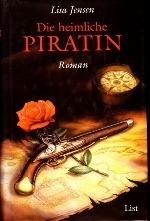 Pirate stories have always been my favorite guilty pleasure. But I could never see myself as the typical, disapproving heroine of the genre, flouncing around in her petticoats while the guys go off and have all the fun. I thought it would be more interesting to imagine a woman as a working member of the crew, who joins up for the same reasons as a man—for the freedom and independence she can't find ashore.
Pirate stories have always been my favorite guilty pleasure. But I could never see myself as the typical, disapproving heroine of the genre, flouncing around in her petticoats while the guys go off and have all the fun. I thought it would be more interesting to imagine a woman as a working member of the crew, who joins up for the same reasons as a man—for the freedom and independence she can't find ashore.
My heroine, Victoria MacKenzie, grows up on a remote Massachusetts farm in the early 1800s with her white father and Mohawk Indian mother. But young Tory loses her family, and a distant aunt abandons her to an oppressive Female Academy in Boston, where she realizes what an outsider she is. In desperation, she runs away to sea.
Foreign rights were snapped up by a German-language publisher who brought out the first edition in hardcover with a beautiful original painting on the jacket. (The German title, Die Heimliche Piratin, translates more or less as The Secret Female Pirate.) Two years later, when the equally gorgeous German trade paperback edition came out—but still, unfortunately, in a language neither I nor my potential readers could read—I decided to do something drastic.
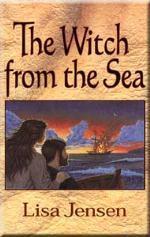 Namely, I got a grip and deleted some 50 manuscript pages of backstory that I perceived as cluttering up my first few chapters. These were solid, character-building scenes, but were they essential to the plot? On second thought, I decided they were slowing down the action in that crucial opening story arc. So—carefully, with the proverbial scalpel, not a meat axe—I cut them out.
Namely, I got a grip and deleted some 50 manuscript pages of backstory that I perceived as cluttering up my first few chapters. These were solid, character-building scenes, but were they essential to the plot? On second thought, I decided they were slowing down the action in that crucial opening story arc. So—carefully, with the proverbial scalpel, not a meat axe—I cut them out.
It must have been the right thing to do. The first U.S. publisher I sent it to, small independent Beagle Bay Books, bought it immediately, and published it under my new title, The Witch From the Sea. The story got up and running so much faster this way, but I still had to mask an interior twinge once or twice when an interviewer or book critic mused that they wished there'd been more material about Tory's backstory. D'oh!
Recently, I noticed on Goodreads that new readers continue to discover my book for the first time, I started to envision a dedicated site for The Witch beyond the single page on my publisher's website, a place to delve more deeply into the life and culture of the era that so obsesses me.
The 1820s were a fascinating period in the West Indies. The War of 1812 was over and the fledgling US Navy was looking for something to do. The Spanish-speaking islands were in revolt against colonial Spain, and the waters were full of ships and sailors trying to make their fortunes—transporting sugar, or slaves, or privateering against Spain. The sea lanes were thronging with dreamers, gold diggers, revolutionaries, con-artists, and, yes, pirates of all races and nations looking to make their fortune in the Indies; in particular, there was a great upsurge in piracy in the shipping lanes around Cuba.
There is also plenty of historical evidence on women in the 18th and 19th centuries who dressed as men and became soldiers or went to sea, to join a husband or lover who was going to war, or simply to escape their own constricted female lives. I thought this was the perfect setting for a coming-of-age story about a young woman trying to free herself from the conventional "rules" of gender, race and class.
 Of course, I'm not exactly Steve Jobs when it comes to tech-savviness. ("Luddite" is the polite term to describe my skills set at the computer.) But I do know that the only kind of site so idiot-proof even I can build it is a blog. So I set one up that includes images, historical background, reviews, samples, and links of interest. But there was still that gaping black hole in the middle of the home page waiting for blog entries.
Of course, I'm not exactly Steve Jobs when it comes to tech-savviness. ("Luddite" is the polite term to describe my skills set at the computer.) But I do know that the only kind of site so idiot-proof even I can build it is a blog. So I set one up that includes images, historical background, reviews, samples, and links of interest. But there was still that gaping black hole in the middle of the home page waiting for blog entries.
Gee, how could I possibly fill it?
That's when I remembered my 50 pages of backstory. The book is written in Tory's voice, writing down her adventures in a purloined ship's logbook while at sea, and I realized the blogspace was the perfect opportunity to leak in entries about her life before the action in the novel begins. These new bits, "From Tory's Log," serve as a sort of patchwork prequel to events in the book.
Let's be honest; not all of what I cut out the first time deserves to be resurrected. And what snippets are worth reviving can always stand a little tweaking. But I'm more than thrilled to have this chance to answer readers' questions about Tory's past life at long last.
~
 Lisa Jensen might have been a pirate in a previous life; either that or she watched too many old Errol Flynn movies on TV in her formative years. Lisa is a veteran film critic, book critic, and newspaper columnist from Santa Cruz, CA. Her swashbuckling historical novel, The Witch From The Sea, was published in 2001.The story Proserpina's Curse, an excerpt from her forthcoming novel, Alias Hook, was published in the Summer, 2006, issue of Paradox Magazine. Sample her arts and entertainment blog at ljo-express.blogspot.com, or visit the Witch website at witchfromsea.blogspot.com.
Lisa Jensen might have been a pirate in a previous life; either that or she watched too many old Errol Flynn movies on TV in her formative years. Lisa is a veteran film critic, book critic, and newspaper columnist from Santa Cruz, CA. Her swashbuckling historical novel, The Witch From The Sea, was published in 2001.The story Proserpina's Curse, an excerpt from her forthcoming novel, Alias Hook, was published in the Summer, 2006, issue of Paradox Magazine. Sample her arts and entertainment blog at ljo-express.blogspot.com, or visit the Witch website at witchfromsea.blogspot.com.

~
Most authors will tell you that editing one's own manuscript can be like amputating a limb. It's especially painful after the book is in print, if readers start asking questions about the material you've left on the cutting-room floor.
It's not that the procedure isn't necessary, especially if the offending appendage has lost its usefulness. Which is how I came to think of the first 50 pages or so of my first novel, a 19th-century swashbuckler then called Blesséd Providence, as my agent repeatedly tried and failed to sell it to a US publisher.
 Pirate stories have always been my favorite guilty pleasure. But I could never see myself as the typical, disapproving heroine of the genre, flouncing around in her petticoats while the guys go off and have all the fun. I thought it would be more interesting to imagine a woman as a working member of the crew, who joins up for the same reasons as a man—for the freedom and independence she can't find ashore.
Pirate stories have always been my favorite guilty pleasure. But I could never see myself as the typical, disapproving heroine of the genre, flouncing around in her petticoats while the guys go off and have all the fun. I thought it would be more interesting to imagine a woman as a working member of the crew, who joins up for the same reasons as a man—for the freedom and independence she can't find ashore. My heroine, Victoria MacKenzie, grows up on a remote Massachusetts farm in the early 1800s with her white father and Mohawk Indian mother. But young Tory loses her family, and a distant aunt abandons her to an oppressive Female Academy in Boston, where she realizes what an outsider she is. In desperation, she runs away to sea.
Foreign rights were snapped up by a German-language publisher who brought out the first edition in hardcover with a beautiful original painting on the jacket. (The German title, Die Heimliche Piratin, translates more or less as The Secret Female Pirate.) Two years later, when the equally gorgeous German trade paperback edition came out—but still, unfortunately, in a language neither I nor my potential readers could read—I decided to do something drastic.
 Namely, I got a grip and deleted some 50 manuscript pages of backstory that I perceived as cluttering up my first few chapters. These were solid, character-building scenes, but were they essential to the plot? On second thought, I decided they were slowing down the action in that crucial opening story arc. So—carefully, with the proverbial scalpel, not a meat axe—I cut them out.
Namely, I got a grip and deleted some 50 manuscript pages of backstory that I perceived as cluttering up my first few chapters. These were solid, character-building scenes, but were they essential to the plot? On second thought, I decided they were slowing down the action in that crucial opening story arc. So—carefully, with the proverbial scalpel, not a meat axe—I cut them out.It must have been the right thing to do. The first U.S. publisher I sent it to, small independent Beagle Bay Books, bought it immediately, and published it under my new title, The Witch From the Sea. The story got up and running so much faster this way, but I still had to mask an interior twinge once or twice when an interviewer or book critic mused that they wished there'd been more material about Tory's backstory. D'oh!
Recently, I noticed on Goodreads that new readers continue to discover my book for the first time, I started to envision a dedicated site for The Witch beyond the single page on my publisher's website, a place to delve more deeply into the life and culture of the era that so obsesses me.
The 1820s were a fascinating period in the West Indies. The War of 1812 was over and the fledgling US Navy was looking for something to do. The Spanish-speaking islands were in revolt against colonial Spain, and the waters were full of ships and sailors trying to make their fortunes—transporting sugar, or slaves, or privateering against Spain. The sea lanes were thronging with dreamers, gold diggers, revolutionaries, con-artists, and, yes, pirates of all races and nations looking to make their fortune in the Indies; in particular, there was a great upsurge in piracy in the shipping lanes around Cuba.
There is also plenty of historical evidence on women in the 18th and 19th centuries who dressed as men and became soldiers or went to sea, to join a husband or lover who was going to war, or simply to escape their own constricted female lives. I thought this was the perfect setting for a coming-of-age story about a young woman trying to free herself from the conventional "rules" of gender, race and class.
 Of course, I'm not exactly Steve Jobs when it comes to tech-savviness. ("Luddite" is the polite term to describe my skills set at the computer.) But I do know that the only kind of site so idiot-proof even I can build it is a blog. So I set one up that includes images, historical background, reviews, samples, and links of interest. But there was still that gaping black hole in the middle of the home page waiting for blog entries.
Of course, I'm not exactly Steve Jobs when it comes to tech-savviness. ("Luddite" is the polite term to describe my skills set at the computer.) But I do know that the only kind of site so idiot-proof even I can build it is a blog. So I set one up that includes images, historical background, reviews, samples, and links of interest. But there was still that gaping black hole in the middle of the home page waiting for blog entries. Gee, how could I possibly fill it?
That's when I remembered my 50 pages of backstory. The book is written in Tory's voice, writing down her adventures in a purloined ship's logbook while at sea, and I realized the blogspace was the perfect opportunity to leak in entries about her life before the action in the novel begins. These new bits, "From Tory's Log," serve as a sort of patchwork prequel to events in the book.
Let's be honest; not all of what I cut out the first time deserves to be resurrected. And what snippets are worth reviving can always stand a little tweaking. But I'm more than thrilled to have this chance to answer readers' questions about Tory's past life at long last.
~
 Lisa Jensen might have been a pirate in a previous life; either that or she watched too many old Errol Flynn movies on TV in her formative years. Lisa is a veteran film critic, book critic, and newspaper columnist from Santa Cruz, CA. Her swashbuckling historical novel, The Witch From The Sea, was published in 2001.The story Proserpina's Curse, an excerpt from her forthcoming novel, Alias Hook, was published in the Summer, 2006, issue of Paradox Magazine. Sample her arts and entertainment blog at ljo-express.blogspot.com, or visit the Witch website at witchfromsea.blogspot.com.
Lisa Jensen might have been a pirate in a previous life; either that or she watched too many old Errol Flynn movies on TV in her formative years. Lisa is a veteran film critic, book critic, and newspaper columnist from Santa Cruz, CA. Her swashbuckling historical novel, The Witch From The Sea, was published in 2001.The story Proserpina's Curse, an excerpt from her forthcoming novel, Alias Hook, was published in the Summer, 2006, issue of Paradox Magazine. Sample her arts and entertainment blog at ljo-express.blogspot.com, or visit the Witch website at witchfromsea.blogspot.com.
Published on July 25, 2012 05:00
July 22, 2012
Book review and giveaway: Kathy Hepinstall, Blue Asylum
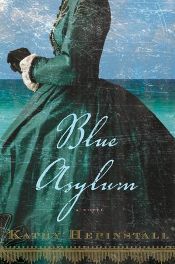 Kathy Hepinstall’s Blue Asylum tells an unusual story of wartime love, injustice, and female determination.
Kathy Hepinstall’s Blue Asylum tells an unusual story of wartime love, injustice, and female determination.Sanibel Island, Florida, in 1864 is a place of sunshine, beautiful white beaches, clear blue water, hermit crabs, sawgrass, alligators, and gumbo limbo trees. It’s also home to one of America’s most elite lunatic asylums, and the residents’ idiosyncrasies and maladies somehow fit the quirky ecology.
The newest patient, Iris Dunleavy, knows she isn’t insane. She’s being punished for embarrassing her spiteful husband, a Virginia plantation owner who cruelly treats his slaves.
Although it claims to be modern, the facility’s methods are often as absurd as the behavior of the supposed lunatics. Superintendent Dr. Henry Cowell equates women’s suffrage with hysteria, his neglected wife takes laudanum, and then there’s the “water treatment” the matron darkly hints at. Despite the serene seaside atmosphere, nobody is content.
Iris’s arrival throws the atmosphere into disarray. Dr. Cowell is perplexed by her defiance yet attracted against his better judgment. As Iris fights for a way to free herself, she becomes close to Ambrose Weller, a tormented Confederate soldier who’s been taught to calm himself by thinking of the color blue.
With everyone convinced of her madness, Iris’s only hope lies in Wendell, Dr. Cowell’s curious and lonely adolescent son. However, her emotional bond with Ambrose will tie her to the island unless she can finagle an escape for them both.
From the very beginning, with Iris's transportation to Sanibel on a ship full of doomed cattle, colorful situations and creative metaphors add to the novel’s originality. But as Iris’s and Ambrose’s personal histories are exposed, a growing sense of dread becomes paramount. The convergence of personalities, locale, and timeframe means that almost anything can happen, and it’s impossible not to feel angry at the terrible treatment and awful choices these characters faced.
Blue Asylum might seem to take a sidelong approach to the horrors of the Civil War, but in the end it makes its points head on. In this effective depiction of a world gone topsy-turvy, the difference between crazy and sane is as hard to explain as the war itself: “Just a sea of delusion, blue at high tide, gray at low.”
Blue Asylum was published by HMH in April at $24.00 (hb, 270pp). I have a nice hardcover copy to give away to an interested blog reader. To enter, fill out the form below. Deadline Tuesday, July 31st. This contest is open internationally.
Published on July 22, 2012 11:00
July 19, 2012
Magdeburg by Heather Richardson: a powerful sketch of the Thirty Years' War
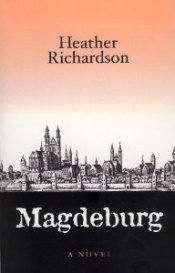 Every once in a while, someone on Amazon or Goodreads or a library discussion site will ask for historical novels set during the Thirty Years' War. This was a series of conflicts fought between the Catholic Holy Roman Empire and Protestant German states and their allies between 1618 and 1648. There aren't many such books, at least in English-language historical fiction... probably because English-speaking countries weren't directly involved.
Every once in a while, someone on Amazon or Goodreads or a library discussion site will ask for historical novels set during the Thirty Years' War. This was a series of conflicts fought between the Catholic Holy Roman Empire and Protestant German states and their allies between 1618 and 1648. There aren't many such books, at least in English-language historical fiction... probably because English-speaking countries weren't directly involved.Titles frequently mentioned include A.L. Berridge's André de Roland series (Honour and the Sword, In the Name of the King) and Arturo Pérez-Reverte's Captain Alastriste books, especially The Sun Over Breda. All are swashbuckling adventure novels. Eric Flint has an alternate history series, too, which I haven't read. I'm sure you'll help me think of others!
For those of us who didn’t know much about the Thirty Years' War beyond how long it lasted, I highly recommend experiencing Heather Richardson's Magdeburg, which is set in 1630-31. The heroine is a young German woman, Christa Henning, a printer's daughter whose days are occupied with the family trade and domestic concerns, such as her best friend Gertrude's pregnancy and hasty marriage and caring for her “touched” younger sister, Elsbeth. Although the Hennings are Lutherans, the religious situation in Magdeburg is realized with nuanced complexity. Christa's father prints Catholic leaflets on the side, and discord is sown in the house when an ultra-pious pastor comes to stay with them.
Richardson also gives us the alternating viewpoint of the male lead (who I'll avoid calling the hero). Lukas Weinsburg is a sergeant marching with an imperial regiment as it makes its approach on Magdeburg. These scenes include all you'd expect of soldiers anywhere, not just the camaraderie, spitefulness, and excessive drinking but also the tedious routine and inaction.
Magdeburg’s residents go about their tasks while enduring the siege, determined to resist what they know is coming, and hoping that Sweden's king, Gustavus Adolphus, can arrive with his forces in time to save them. He doesn't.
War is a messy, chaotic business, but the author provides a lucid illustration of the larger political and religious picture as one group overtakes the other. I feel obligated to say something about the novel’s eleventh chapter, which is a haunting, poetic masterpiece. It opens: "It was midnight, but no one knew it." The perspective becomes omniscient as it roams away from Lukas and Christa to survey the city as a whole at its darkest hour. In a mere three pages of careful glimpses, Richardson conveys the enormity of the devastation, both material and personal.
I won’t reveal more of the plot, save to affirm that things don't end on that doleful note. Magdeburg's survivors struggle to regain their city and a sense of themselves. The characters are devoid of cliché, and whatever their views on religion, it's central to their lives. They don’t react like 21st-century people would, but our generation isn’t exactly free of violence springing from faith-based differences, either.
Magdeburgwas published by Belfast's Lagan Press in 2010 (trade pb, 349pp). You can snag it from Amazon UK or other online bookstores, or do what I did and order it directly from the publisher for £9.99 – which as I recall included postage.
Published on July 19, 2012 06:00
July 16, 2012
Book review: Four Sisters, All Queens, by Sherry Jones
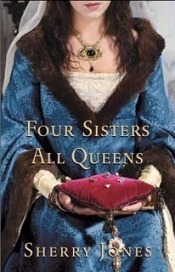 Family and politics are inextricably tangled in Sherry Jones's Four Sisters, All Queens, which examines feminine power in 13th-century England and Europe. One could expect no less in a novel about the four daughters of the resolute Beatrice of Savoy, Countess of Provence, who narrates the prologue. Marguerite, Eléonore, Sanchia, and Beatrice may not have been the only quartet of sisters to become queens, but they may have left the grandest legacy, having shaped their world both with and without their husbands’ support.
Family and politics are inextricably tangled in Sherry Jones's Four Sisters, All Queens, which examines feminine power in 13th-century England and Europe. One could expect no less in a novel about the four daughters of the resolute Beatrice of Savoy, Countess of Provence, who narrates the prologue. Marguerite, Eléonore, Sanchia, and Beatrice may not have been the only quartet of sisters to become queens, but they may have left the grandest legacy, having shaped their world both with and without their husbands’ support.Each chapter of this sparkling literary epic starts by listing the viewpoint, location, year, and age of each protagonist. This makes it easy to keep track of events, which proceed from Marguerite’s adolescence in 1233 through her middle age in 1271. She has the distinction of achieving her mother’s aspirations first, becoming queen to France’s Louis IX.
Despite Marguerite’s status, being married to an overly pious mama’s boy and future saint is no walk in the park, especially when her proud and jealous mother-in-law, the “White Queen” Blanche de Castille, denigrates her and refuses to let them consummate their marriage. “She simply loves power too much to share it with a husband. Or with her son, I hear,” Marguerite is warned before her coronation. Clever and clear-sighted, Marguerite demonstrates her bravery while fighting for her promised dowry: her Provençal homeland.
All four girls are reminded by their mother that “family comes first,” a theme that repeats throughout the book, but it’s Eléonore’s husband who exemplifies this most publicly. Kind but weak, Henry III of England angers his barons by placing Eléonore’s Savoyard uncles and his own Lusignan half-brothers in high posts. A determined woman who aims to prove herself to her adopted country, Eléonore knows her husband adores her but is forced to endure the label of “foreigner” and raise her family in an unwelcoming place.
Sanchia and Beatrice don’t marry kings but the younger brothers of their elder sisters’ husbands and are caught up in their battles to gain crowns of their own. Shy, beautiful Sanchia fails to achieve her greatest desire. She longs for the convent but, to please her family, weds a man who spouts such affectionate lines as “Love is the delicate oil, but marriage the vinegar.” Beatrice, to her surprise, finds that her husband’s ambitions neatly mirror hers, but one of her father’s actions sets her up for a lifelong conflict with her eldest sister. With Marguerite’s and Eléonore’s personalities so forceful, it would be easy for her and Sanchia to fade into the background, but both have a vivid presence on the page.
Each woman has a hard road to tread; throughout their lives, they achieve small triumphs but meet with many setbacks. Their tale not only encompasses sibling rivalry but its accompanying struggles for political supremacy and also religious intolerance, with both England’s Jews and France’s Cathars meeting with much worse than ordinary prejudice. Put simply, this isn’t a happy story overall, but Jones stays refreshingly true to the realism of the age while depicting each courageous woman’s unsung heroism.
Rather than producing a standard family saga, she focuses on the sisters’ generation and their emotional connections over time. While this makes the large cast more manageable for the reader, their many children can feel blurred and indistinct as a result – even the future monarchs among them. (Henry and Eléonore’s beloved daughter Katherine is a memorable exception.) The genealogical charts at the beginning are numerous and necessary.
The action sweeps from the magnificent cathedrals of northern France to the Egyptian port of Damietta on the bloody Seventh Crusade to the glittering chill of Aachen, Germany, but the impressions the women formed in their childhood home, with its troubadours and trobairitz and “days of wine and poetry,” continue to influence them. The novel’s elegant language has a subtle lyricism about it, as if to emphasize that they carry Provence with them wherever they go.
Four Sisters, All Queens was published by Gallery/Simon & Schuster in May at $15.99/C$18.99 in trade paperback (434pp + epilogue and readers' guide).
Published on July 16, 2012 14:00
July 13, 2012
So you want to write a novel about King Arthur? Tony Hays on writing and reading about well-known historical figures
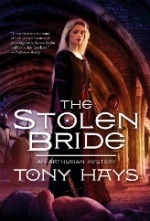 Tony Hays is stopping by today with a provocative essay on the advantages and perils of writing about famous names from history. He knows whereof he speaks, having constructed a series of novels around one of England's most legendary heroes.
Tony Hays is stopping by today with a provocative essay on the advantages and perils of writing about famous names from history. He knows whereof he speaks, having constructed a series of novels around one of England's most legendary heroes. The Stolen Bride (Forge, April 2012), volume four of his Arthurian Mysteries, tells a self-contained story while adding to his ongoing saga about Malgwyn, counselor to King Arthur in a gritty 5th-century Britain. Sent to the distant western realm of King Doged to broker a truce, Malgwyn finds himself asked to help solve his elderly host's murder. Doged's enigmatic young widow, Ysbail, ultimately joins Arthur's longtime consort, Guinevere, as one of the stronger female figures in Arthurian retellings. This excellent series has been getting stronger with each new entry. Hope you will enjoy Tony's post!
~
So you want to write a novel about King Arthur, or Queen Elizabeth I, or Joan of Arc, or Guinevere, or Merlin, or Abraham Lincoln or Richard the Lionhearted, or Genghis Khan? Certainly a noble endeavor. Everyone loves a book about Arthur or the Tudors or the saintly Joan. Publishers may immediately think of such figures’ perennial popularity. But, the first thing you have to remember is that hundreds, if not thousands, of authors have already gone where you are about to tread. And millions of readers have already tested those waters, and they have already formed a mental picture of each of those characters, an image with which yours may or may not jibe. And if your characterization doesn’t coincide with their own, readers will let you know, quickly and loudly. Sailing into such well-traveled waters as Arthurian or Tudor legend is often akin to sailing into a mine-laden Subic Bay during World War II.
Different is good. Different interpretations of historical figures make readers think. As long as the interpretation doesn’t take liberties with the facts. While Abraham Lincoln, Vampire Hunter may have sold millions of copies, nobody I know considers it a historical novel. No, it’s a gimmick intended to tap the sometimes inexplicable interest people have in vampires. My friend C.W. Gortner, in his book The Last Queen about Queen Juana of Castile, took a woman whose nickname was “la Loca” or “The Mad” and presented her in a convincing, accurate, yet sympathetic way. It worked. But C.W. didn’t have a lot of fictional representations already out there to compete with. That takes nothing away from his achievement; it just lets him breathe a little easier.
I always thought that Gore Vidal did a great job with Lincoln because he opted to never pretend to know what the great man was thinking. He let other characters tell the tale, and his Lincoln comes across as shrewd, folksy and, ultimately, enigmatic. Oh, and there’s no hint of vampire hunting in his background. Someday, I’d like to write a YA mystery series set in Lincoln’s White House, where Lincoln uses his two boys and their friends, the Taft children, as sort of Baker Street Irregulars, or perhaps it should be Pennsylvania Avenue Irregulars. And, if I do, I will owe much to Vidal’s characterization, not to mention Sir Arthur Conan Doyle.
In my own Arthurian mystery series, I take different views of just about every character, and I don’t have any breathing space. Everybody has heard of King Arthur, Guinevere, Merlin and the gang. They may have read Thomas Malory or T.H. White or just seen The Sword in the Stone. But nearly everybody has a preconceived notion. Guinevere is portrayed as either a wide-eyed innocent ala The First Knight, or a seasoned adulterer. I chose not to go that way. I wanted a Guinevere who was strong, independent. I needed an Arthur who was strong, idealistic, but not quite as clueless as some portrayals. I have no magic. My Arthur is a man who walks the ground, gets dirty and sometimes smells. And I have no Lancelot. My Arthurian universe nestles next to reality. Lancelot never existed.
I have paid a price for ignoring Malory, Chretien de Troyes, Wace and T.H. White. One reviewer took me to task very profanely for dismissing the later romance writers. But I knew that was a possibility before I started. In general, I’ve found that American readers are less willing to countenance new interpretations of old characters. The British, for whom Arthur is a national hero, are generally far more accepting.
My point is this. If you are a writer, don’t play fast and loose with historical fact to accommodate your interpretation of a historical character; readers of historical fiction are demanding ones, and they will call you out if you make errors. If you are a reader, don’t let preconceived notions of historical figures color how you react to a new characterization. You could learn something new about the person and the period. And we lovers of historical fiction yearn for two things. We want to be entertained, yes. But we also want to be educated as we go.
Published on July 13, 2012 09:00
July 7, 2012
Book review: The Shoemaker's Wife, by Adriana Trigiani
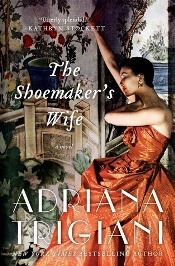 Adriana Trigiani's The Shoemaker’s Wife is an immense, and immensely enjoyable, epic that personalizes the immigrant experience in early 20th-century America. Through the story of Enza Ravanelli and Ciro Lazzari, characters based on her grandparents, she presents an affectionate portrait of how newcomers to these shores adjusted to a completely different way of life. Strong and determined, they not only achieved their own dreams but helped their families back home realize theirs.
Adriana Trigiani's The Shoemaker’s Wife is an immense, and immensely enjoyable, epic that personalizes the immigrant experience in early 20th-century America. Through the story of Enza Ravanelli and Ciro Lazzari, characters based on her grandparents, she presents an affectionate portrait of how newcomers to these shores adjusted to a completely different way of life. Strong and determined, they not only achieved their own dreams but helped their families back home realize theirs. Teenagers Enza and Ciro first meet over a gravesite in the village of Schilpario in the Italian Alps, which establishes ties that will last their lifetimes. The year is 1910, and money is tight. With his widowed mother unable to care for them, Ciro and his older brother have been raised in a convent by caring nuns – an arrangement which lasts until Ciro catches the priest in a compromising position. The nuns find a new situation for him, although it means he and his brother will be separated. Enza, the eldest daughter in a close family with financial problems, wisely knows better opportunities lie overseas and emigrates with her father shortly afterward.
Their stories proceed in parallel as Enza becomes a servant and factory worker in Hoboken, New Jersey, and then a seamstress for the Metropolitan Opera, while Ciro finds his calling as an apprentice shoemaker in New York City.
Ciro is handsome, strongly built, and popular with women, and Trigiani shows how his childhood abandonment makes him shy away from romantic commitment. (For a novel about a ladies’ man, the love scenes are quite clean.) Enza is smart and self-sacrificing, mailing nearly all of her earnings back to Italy to help her mother and siblings build a new home. There are several poignant moments as she realizes she’s allowed to live for herself, too. Neither Enza nor Ciro forgets the other, and circumstances – war, overlapping circumstances, random chance – draw them first together and then apart until they reunite at last and marry.
From the magnificent slopes of Italy’s Pizzo Camino to the Met’s impressively vast costume shop to the small mining towns of Minnesota’s Iron Range, the profuse amount of detail serves to enliven the plot. For immigrants who start out with little, so much about America feels awe-inspiring and new, and readers experience these sensations alongside them.
And the food! No novel celebrating Italian heritage would be complete without it, and the meal Enza and her Irish best friend, Laura, prepare for Enrico Caruso – gnocchi with sage, green salad, and wine – sounds scrumptious. He may be a world-famous opera star, but not even Caruso forgets where he came from.
The short sections covering Ciro’s WWI involvement feel sparse compared to the rest, especially considering the impact it has on him and his family. In the grand scheme of things, though, this may have been a wise move; it gives the novel a tighter focus.
Trigiani writes with a warm, comforting tone; her novel reads like the labor of love it is, one filled with the spirit of togetherness. Although Ciro and Enza are forced to become independent, neither is ever alone. They form enduring friendships with others who give them strength and become their second families. These connections help them endure the tragedies they face.
Seeing as it spans two continents and many decades, The Shoemaker’s Wife is a lengthy and immersive novel. Fortunately, the storytelling doesn’t drag, and the author’s thorough approach results in a deep look at Italian immigrant life and traditions and the seemingly little moments that define her characters’ event-filled lives.
-----
 The Shoemaker’s Wife was published by Harper in April at $26.99 in hardcover (475pp), including one of the most detailed acknowledgments sections I’ve seen! In addition to providing food for thought about the people who helped Enza and Ciro (and others like them) adjust to their new country, the novel concluded by making me ponder the family members, researchers, editors, agents, publicists, and more who aided the author over the 25 years it took her to create and publish her work.
The Shoemaker’s Wife was published by Harper in April at $26.99 in hardcover (475pp), including one of the most detailed acknowledgments sections I’ve seen! In addition to providing food for thought about the people who helped Enza and Ciro (and others like them) adjust to their new country, the novel concluded by making me ponder the family members, researchers, editors, agents, publicists, and more who aided the author over the 25 years it took her to create and publish her work. And as a sidenote on unexpected connections, the Minnesota city where the Lazzaris settle was immediately recognizable to me as the place where a character from one of my favorite movies lived (someone based on a real person). It gave me a major “squee” moment to see him appear in the book.
At 475 pages, The Shoemaker's Wife qualifies for the Chunkster Challenge.
Published on July 07, 2012 13:00
July 2, 2012
Spanish queens, history, and character: An interview with C.W. Gortner, author of The Queen's Vow
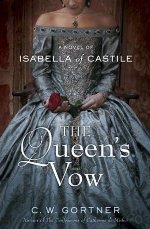 The following interview is based upon a phone conversation I had with novelist C.W. (Christopher) Gortner about his latest biographical novel, The Queen's Vow, which presents a new and eye-opening perspective on Isabella of Castile.
The following interview is based upon a phone conversation I had with novelist C.W. (Christopher) Gortner about his latest biographical novel, The Queen's Vow, which presents a new and eye-opening perspective on Isabella of Castile. Readers will remember Isabella for her sponsorship of Christopher Columbus's expedition in 1492 and her role in bringing the Inquisition to Spain. Although her marriage to King Ferdinand of Aragon (Fernando in the book) is also well known, before reading this book I hadn't known about Isabella's impoverished childhood or her complicated struggle to be proclaimed the heir to her half-brother's throne.
Isabella isn't the author's first royal heroine, although she's cast in a different mold from his earlier protagonists - and one thing I admire is how he aims to stay true to the historical essence of each woman he writes about. Also, as he grew up in Spain, he provides his views on the country's history and culture and how his background knowledge influenced his character development... among other things. Christopher is a good friend as well as an excellent writer, and he always has articulate, insightful things to say about history and about writing - as anyone who's seen him on a Historical Novel Society conference panel will know. Hope you'll enjoy the discussion!
You’ve taken on some tough subjects in your three biographical novels. First in The Last Queen, you have Juana of Castile, with her supposed madness; then later Catherine de Medici, with her ruthlessness and rumors that she might have incited the St. Bartholomew’s Day Massacre. Now with The Queen’s Vow, you’ve taken on Isabella, who reestablished the Inquisition and expelled the Jews and Moors from Spain. Which of these women – or situations – did you find most challenging to write about?
Each one presented its own challenges. With Juana, I had to deal with a character who outwardly appears helpless, a victim, and it’s always challenging in the modern day to write a character like that. We have so many preconceptions now about female empowerment; everyone wants that kick-ass heroine, Lara Croft in a gown. In portraying Juana, the challenge was to show a woman who had a lot of inner courage but none of the benefits of modern-day liberation. It’s hard for us to realize that many women, particularly royal ones, often found themselves in these terrifying situations. I had to figure out how to make Juana accessible to the modern-day reader without making her look like a doormat.
With Catherine de Medici, it was easier in that respect, because she exercised power; she’s no push-over. But then we have the controversy: she’s been segregated into the role of a sexless, reptilian being who rules through her children, without redeeming qualities. It was challenging to reveal the flesh-and-blood woman behind her legend and take the risk of showing some of the things she sacrifices for power. Again, to this day women do this; they give up certain things to have other things, though we’re bombarded by media slogans that promise we can have it all–the high-octane career, the perfect family, eternal beauty, and unending wealth. The media makes it look effortless, but real life, whether in the 21st or the 16th century, doesn’t work that way. Very few of us get to have it all; instead, we get to make choices.
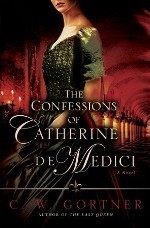
That said, overall Isabella has been the most challenging, because she’s so polarizing. She was both exceptional for her times and a product of her times, and I haven’t written a female character until now with such extreme duality. She’s extraordinary in her vision of a united country, in how she wants women to be educated; and yet, in her religious view, she’s very much of the 15th century. Part of what you must do as a writer is set aside personal preferences as to what you believe a character should be, and search that character for what motivates and moves them. For me, the challenge with Isabella was to be true to her ideology, though I don’t agree with it.
When I first heard about the novel, I certainly didn’t know anything about – and believe most people won’t know anything about – Isabella’s childhood and the struggles she had to establish herself as queen, and that she was never expected to be queen at all. We only hear about her involvement with Columbus, the Inquisition, and her marriage to Fernando, which united Spain. When did you first hear about her youth? Growing up in Spain, had you learned this about her?
I grew up with the standard story: she conquered Spain and kicked out the Moors. I didn’t hear a lot about the Jews growing up. It was the last years of Franco’s regime and I was educated by Jesuits, so I didn’t learn about that aspect of history; it wasn’t hidden but it wasn’t discussed, either. It wasn’t until I started researching my first novel, The Last Queen, that I discovered the controversy surrounding Isabella. She’s quite a strong character in that book, though I focus on the final years of her reign, as seen through her daughter’s eyes. Isabella has already accomplished her best and her worst.
It was while writing that book, however, that I discovered the relatively unknown story of Isabella’s tumultuous ascent to the throne and struggle to assert herself as queen. I remember thinking, Wow. She had such a difficult path. So, when I decided to write The Queen’s Vow I returned to the original sources and then to some newer ones; that’s how I discovered, for example, that she’d had such a rudimentary education. Comparing her education to that of Elizabeth I, for example, the contrast is marked. People may not have believed Elizabeth would ever rule but she was certainly prepared as if she might be. On the other hand, Isabella had only the basics. She was literate but she didn’t even speak Latin, which was the language of diplomacy at the time, and the emphasis was on her preparation for being a wife, a consort.
The more I discovered about the challenges that she faced not only politically and dynastically but also personally, I realized I had a great story. And unlike the deeds she’s so well-known for—Columbus, the Inquisition, the conquest of Granada—her youth is something we rarely hear about. We always imagine her somber and ordering people about, dressed in dour clothes. We don’t get a sense of who she was before. I wanted to explore how she became the queen and woman we all think we know.
Let me ask about transitioning between The Last Queen and The Queen’s Vow. Neither is a sequel to the other – they both stand alone – but at the same time, I’d think you’d have to establish a kind of continuity between them to keep the characters consistent. Did you come across any special challenges, especially with regard to Fernando?
Part of the great thing about writing The Last Queen first was that I had the opportunity to write Isabella and Fernando as older characters. I didn’t want to repeat the same events from that book, so having already established this part of their lives freed me to focus on the story I wanted to tell. The Queen’s Vow covers Isabella’s life up to the pivotal year of 1492; in a sense, it backs into The Last Queen and her last twelve years. As I’d developed her in my first novel as the older queen it informed my depiction of her as the younger one, and more importantly, as the beleaguered princess. None of us are born fully developed; we are shaped by our experiences. In The Last Queen, Isabella has been transformed by personal tragedy, by loss and responsibility and declining health. She is not the woman we meet in The Queen’s Vow, and yet the seeds of who she will become are there. It was wonderful, actually, because I had the vision of this character firmly in my head.
Much the same happened with Juana. In The Last Queen, we hear her story from her point of view. But in The Queen’s Vow, we see her as child through Isabella’s eyes. It was fun to play with these different portrayals of her, for the way Isabella interprets her daughter is very different from how Juana will interpret herself.
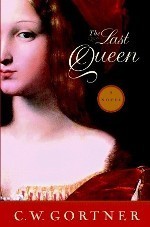 In The Last Queen, Fernando is the older king; sly, duplicitous, a man who many believe was the model for Machiavelli’s The Prince. In The Queen’s Vow, he too carries these seeds of who he will eventually become, but again, his experiences shape him. I loved portraying him as a young, brash prince, who knows he’s considered his wife’s inferior as far as power and the size of his kingdom are concerned. He’s out to prove himself. He loves Isabella but also wrestles with his sense of inadequacy. I also discovered that in the early years of their marriage, he was very much the spur behind Isabella’s caution. Her experiences taught her to weigh all the odds before acting; she wasn’t an impulsive decision-maker. Fernando goaded her for both bad and good. So, it wasn’t challenging in the sense that I had to remember to stay true to his character; I had the advantage that I’d met him before, as I had Isabella, and so things just clicked as I wrote. Also, in this novel, we get to see how he and Isabella started their marriage; it weathered trials and became one of mutual passion and understanding, a rarity for the era.
In The Last Queen, Fernando is the older king; sly, duplicitous, a man who many believe was the model for Machiavelli’s The Prince. In The Queen’s Vow, he too carries these seeds of who he will eventually become, but again, his experiences shape him. I loved portraying him as a young, brash prince, who knows he’s considered his wife’s inferior as far as power and the size of his kingdom are concerned. He’s out to prove himself. He loves Isabella but also wrestles with his sense of inadequacy. I also discovered that in the early years of their marriage, he was very much the spur behind Isabella’s caution. Her experiences taught her to weigh all the odds before acting; she wasn’t an impulsive decision-maker. Fernando goaded her for both bad and good. So, it wasn’t challenging in the sense that I had to remember to stay true to his character; I had the advantage that I’d met him before, as I had Isabella, and so things just clicked as I wrote. Also, in this novel, we get to see how he and Isabella started their marriage; it weathered trials and became one of mutual passion and understanding, a rarity for the era. That’s interesting – it sounds like it gave you a good opportunity to explore their motivations, to see how they became that way.
Yes, it actually worked in reverse. Fernando turned out to be something of a revelation because the man he became at the end of his life is quite different than the man he started out as, though when we go back and trace his experiences, we can see exactly how and why the changes occur. He’s the most transformative of my characters, while Isabella stays consistent for the most part. She has a steadfast personality, even as she turns more and more to her faith as she suffers losses; she also loses some of her spontaneity and innocence, but the moments that shape her are all there.
With regard to the shaping of Isabella’s character, there’s one point in the book where she muses on Spain’s history. She remembers that there had been other female rulers of Castile, but that they’d “encountered relentless opposition” and that “none had lived a happy life.” Who were some of them, and what lessons would they have taught Isabella?
Queen Urraca [1079-1126] was one of the most famous Castilian queens. Castile was divided; it and León were separate kingdoms for a long historical period. In my novels, I don’t mention León because by then it’s been incorporated into Castile. Urraca’s reign straddled both kingdoms. She faced incredible opposition as a female ruler, and because of the division in the country as a whole. The Moors were also much stronger during her era; they held almost all of southern Spain. She had the constant challenge of pacifying and solidifying Castile and León while dealing with the Moors and her treacherous nobles. Some readers may be surprised that the Reconquest didn’t begin with Isabella and Fernando; they completed the task but every Christian ruler before them had taken it up and pushed the Moors further back, so that by Isabella and Fernando’s reign, the Moors held a small corner of their previous domain: the kingdom of Granada. Urraca managed to overcome these challenges to a certain extent, but she didn’t have a happy ending. Another later queen, Maria de Molina [1265-1321], served as a regent for her son and dealt with tremendous upheaval. Like Isabella, these ladies faced the prejudice of being a sovereign queen. Castile didn’t abide by Salic Law, but misogyny was alive and well.
Their examples probably taught Isabella what not to do. She grew up in a rural environment with a mother who was delusional (probably a manic depressive); she lacked education and training, but she showed an early interest in history. She must have realized at some point that in order to rule successfully, she would need a supportive king at her side. I think she had this innate sense of what Fernando could bring the table. She might also have been motivated by a romantic angle; we know, for example, that she asked for portraits of Fernando. Their first meeting in the book, in Segovia, is fictional, because I had to establish them as characters earlier, before the night of their wedding. But she’d been watching him for years and they’d been betrothed in early childhood for a time; he was not a complete stranger to her. It is possible they met before and it wasn’t recorded it because no one thought it important. Isabella had a very Spanish aversion to marrying a foreigner. She wanted someone of her caliber, who understood her world. She couldn’t imagine leaving Spain and that’s something about her that I really responded to.
This was actually one of the questions I meant to ask later on – what are some of the things that, to you, make a character quintessentially Spanish?
 author C.W. GortnerIt’s something you feel, deep inside, when you’re from Spain. It’s not something you can get from just visiting the country or reading books about it. You have to know that Spaniards – we have this deep attachment to our land. Most the Spaniards I’ve met in the United States have either eventually returned home or re-created a piece of Spain here, even if they’ve been away for years. You can curse the country to high heaven, criticize it, swear up and down that you’ll never live there again, that there are so many things that are wrong and you don’t like, and yet…
author C.W. GortnerIt’s something you feel, deep inside, when you’re from Spain. It’s not something you can get from just visiting the country or reading books about it. You have to know that Spaniards – we have this deep attachment to our land. Most the Spaniards I’ve met in the United States have either eventually returned home or re-created a piece of Spain here, even if they’ve been away for years. You can curse the country to high heaven, criticize it, swear up and down that you’ll never live there again, that there are so many things that are wrong and you don’t like, and yet…The other thing that makes a character quintessentially Spanish is this ingrained duality. Some of the most famous characters in Spanish history, they’re both deeply religious and highly motivated by acquisition, always seeking to expand the boundaries of their kingdom. Isabella, Charles V, Philip II: these are imperialistic rulers. Some would also say they’re fanatics. This contrast between nobility and brutality, between faith and beauty: I find it to be uniquely Spanish. To me, it’s embodied in bullfighting – the painstaking ritual, the costume, the drama: these are all beautiful, and yet the act itself is savage.
In your bibliography at the end, I noticed that half of your resources are in Spanish, and you’ve alerted readers to this, too. What were some things you wouldn’t have known otherwise, if you weren’t able to read Spanish?
I wouldn’t have understood the complexity of some of the deliberations around the establishment of the Inquisition. Many of the reports that went back and forth between Isabella and the Ecumenical Council that she organized dealt with entwined socio-cultural, political, and religious issues unique to the time. When Isabella came to the throne, the Spanish Church was in shambles. We can sort of compare it to what [Thomas] Cromwell said he unearthed in the monasteries in England; we don’t find strict Catholicism being practiced, but rather a curious, almost hybridization of Spain’s three prevailing faiths: Jewish, Muslim, and Christian. We also see blatant simony, bribery, the selling of favors and indulgences: all the usual stuff. These reports that were forwarded to Isabella also cited that in one out of every two parishes, the priest had a concubine living with him. They called these women ‘barrangas.’ I didn’t even know what the term meant at first!
Isabella requested that this Council investigate corruption in the church, as it was deemed, as well as reports of non-conformity among conversos – Jews who’d converted to Christianity, most of them under duress during an intense period of persecution in the medieval era. She was troubled by ongoing rumors that many conversos were practicing Christianity at face-value or combining Judaism with Christian practices. Some, it was said, hadn’t really converted at all. To Isabella, this would have been gravely disturbing. The souls of her subjects, the very spiritual health of her kingdom, were at risk. Yet again, at first caution overrode even her piety. It took her almost four years to implement the papal bull that granted her permission to authorize the Inquisition’s revival. She instituted a program of spiritual education, dispatching trained priests to guide her subjects back to the ‘proper’ way of worship; it failed, but I did not make this up. If I hadn’t seen those reports in Spanish, I wouldn’t have understood the complexity of what she faced. I’m not condoning her role in the Inquisition, of course; I think she made a horrifying mistake that unleashed a monstrous wave of terror and suffering, but I do believe she agonized over her decision. I think she believed she had done everything she could to avoid persecution.
I can see that, and like you said, these are things people just don’t know. And I understand that you can’t include every little fact into the book.
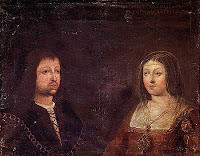 Fernando and Isabella, wedding portraitYes, you have to choose how much to impart. Also, Isabella wasn’t being naïve when she turned to this council for advice; it’s what rulers did, and still do. They seek experts to guide them; they set up meetings; they have people who report to people who report back to them. It’s misguided to think she sat down with a fully formed plan to implement the Inquisition. That would have been contrary to her nature, both as a person and queen. In the end, she felt the church was so corrupted there was no other way to tackle the problem of non-conformity. I think she was naïve, however, in her belief that she could control it. And there is evidence to suggest that Fernando pushed hard for the Inquisition, that he wanted it set up sooner than she did, because of the revolt of the Moors in Granada. He used the start of the crusade as justification to compel Isabella to say yes, because they would be away from Castile for long stretches of time and who knew what those conversos might get up to in their absence?
Fernando and Isabella, wedding portraitYes, you have to choose how much to impart. Also, Isabella wasn’t being naïve when she turned to this council for advice; it’s what rulers did, and still do. They seek experts to guide them; they set up meetings; they have people who report to people who report back to them. It’s misguided to think she sat down with a fully formed plan to implement the Inquisition. That would have been contrary to her nature, both as a person and queen. In the end, she felt the church was so corrupted there was no other way to tackle the problem of non-conformity. I think she was naïve, however, in her belief that she could control it. And there is evidence to suggest that Fernando pushed hard for the Inquisition, that he wanted it set up sooner than she did, because of the revolt of the Moors in Granada. He used the start of the crusade as justification to compel Isabella to say yes, because they would be away from Castile for long stretches of time and who knew what those conversos might get up to in their absence?I’ve read – and based on my knowledge of the field, this is true – that The Queen’s Vow is the first English-language novel about Isabella in about 40 years, just as The Last Queen was the first novel about Juana in some time.
Yes, Jean Plaidy wrote a trilogy of novels on Isabella and her daughters; and Lawrence Schoonover wrote a novel called The Queen’s Cross. Also, Norah Lofts wrote Crown of Aloes.
All of my copies of those are out-of-print ratty paperbacks! In many ways, then, your novels will be English-language readers’ first full introductions to these women. Did you feel pressured in any way while you were writing, knowing you would be representing them to the reading public?
No, not really. I didn’t feel any specific pressure because of the length of time between a past novel and mine. My pressure stemmed from my desire to portray these women as true to their era, true to what is known about them, while recreating their hidden sides, who they may have been, so readers would understand both what they faced and why they acted as they did. I wanted to describe their unique set of circumstances and that of the times, to give an accurate and fair portrayal of their struggles and triumphs. In the end, I do write fiction. These are novels, not biographies. My primary function is to entertain, but I still take the task of bringing these women to life seriously. I don’t want to defame them.
Thank you so much for having me, Sarah. It’s always an honor to visit your blog. I hope your readers enjoy The Queen’s Vow. To find out more about me and my work, please visit www.cwgortner.com.

For other stops on C.W. Gortner's virtual tour, see the tour schedule. The Queen's Vow was published in June by Ballantine in hardcover ($25.00, 400pp).
Published on July 02, 2012 05:00
June 29, 2012
A look at 90 years of Greek history via Victoria Hislop's The Thread
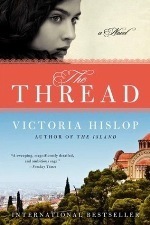 In late 2010 I reviewed Victoria Hislop's The Island for the A-Z in Historical Fiction challenge. It twined through the history of Spinalonga, an isle off the Cretan coast which was kept as a leper colony, but the overall message was more uplifting than tragic. When I learned that Hislop was returning to Greece with her newest book, The Thread, I awaited it with anticipation. And then it was sent to me for review... a nice surprise!
In late 2010 I reviewed Victoria Hislop's The Island for the A-Z in Historical Fiction challenge. It twined through the history of Spinalonga, an isle off the Cretan coast which was kept as a leper colony, but the overall message was more uplifting than tragic. When I learned that Hislop was returning to Greece with her newest book, The Thread, I awaited it with anticipation. And then it was sent to me for review... a nice surprise!Although I haven't read her middle book yet (The Return, about the Spanish Civil War) I agree with reviewers who speak of the great improvement in her writing style over time. The Thread unites her already firm storytelling skills and historical sensibility with nuanced characterizations. It's an epic story that never drags, one full of devastation and hope - and yes, it would make a good book club choice. Don't let this description scare you off, though. I dislike sappy novels, and fortunately The Thread isn't one of them.
Combining a keen eye for detail with her usual fluid writing style, Hislop presents an engrossing excursion to Thessaloniki, Greece’s second-largest metropolis, a relatively unexplored setting for fiction. By the novel’s end, however, readers will be intimately acquainted with its troubled politics and rich cultural heritage.
The Thread begins in 1917 and spans 90 years, tracing the lives of Dimitri, son of a wealthy, coldhearted cloth merchant, and Katerina, who arrives as a child refugee from Smyrna after the Greco-Turkish War and becomes a skilled embroiderer in a Jewish family’s workshop. Circumstances place them in the same neighborhood on Irini Street, whose kindly residents make up for its lack of affluence.
Childhood friends, Dimitri and Katerina eventually fall in love and marry, an event foreshadowed by the novel’s modern frame. Their interwoven stories skillfully incorporate Greece’s Nazi occupation and civil war, in which Dimitri takes a risky antigovernment stance.
This fast-moving, touching saga about tragedy, recovery, and the real meaning of family is full of dramatic incidents demonstrating the city’s transformation and resilience.
The Thread is published in July by Harper in trade pb at $14.99 (400pp). In the UK, the publisher is Headline Review, from whom appeared in hardcover last October; the trade pb appeared in May at £7.99. Around the same time, the author wrote an article for The Telegraph about her passion for Greece (where her books are huge bestsellers, and where The Island was adapted into a miniseries) and her sad observations on the financial crisis plaguing the country.
Portions of this post were previously published in the May 15th issue of Booklist.
Published on June 29, 2012 17:33
June 21, 2012
Book review: The Woman at the Light, by Joanna Brady
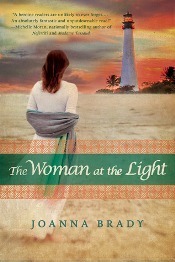 Joanna Brady’s good-natured and satisfying first novel is set in and around Key West during its first years under American control – nearly a century before Hemingway and other literati made the sleepy little city their own.
Joanna Brady’s good-natured and satisfying first novel is set in and around Key West during its first years under American control – nearly a century before Hemingway and other literati made the sleepy little city their own. In 1839, Emily Lowry’s husband is the caretaker of the lighthouse on Wreckers' Cay, a remote neighbor isle in southwestern Florida. When Martin fails to return from a boating trip, she and her three (soon to be four) children are left to fend for themselves. A light-skinned black man who appears on their island months later, after escaping a Caribbean-bound slave ship, turns out to be the answer to their prayers: Andrew is polite, strong, and handy with tools. He's not bad looking, either.
With her pregnancy far advanced, Emily shows Andrew how to tend the light that alerts ships away from the shallow waters and coral reefs. Far from the rigid society of her New Orleans birthplace, Emily lets her guard down and allows herself to fall in love with this charismatic man while hiding him from occasional visitors and persistent would-be suitors.
Keeping to antebellum-era realities, Brady knows their peaceful idyll can’t last and throws many obstacles their way, even more than the ones you’d expect. Some of the plot turns are fanciful, and I found myself wanting to reach back 170 years to remind idealistic Emily to be more cautious. Her openness and spunk give her an appealing personality, though, and she deserves some happiness in her life. Her narrative also reveals the full history of her marriage to Martin, which isn’t the great love match she hoped for.
Her entertaining story is filled with mystery (What really happened to Martin? Will Andrew be discovered? How did he make it off the ship while still in shackles?) as well as romance, episodes of tragedy, and bursts of clever humor. Emily's children play active roles, too. The historical details are sufficient without being overwhelming, and the novel provides an enjoyable glimpse of the 19th-century Florida Keys, with its bustling mélange of American, Bahamian, and Cuban influences. Emily sails to and tours around Cuba – how times have changed! – and its importance to Spanish industry is highlighted.
Keeping a lighthouse in top shape was a strenuous, important task, and in explaining all the work involved – climbing the many stairs, trimming the wick daily, polishing the glass, and more – Brady also honors the real-life female lightkeepers on whom Emily is modeled.
The Woman at the Light will be published by St. Martin's Press on July 3rd at $14.99/$16.99 CAN in trade paperback (322pp). I snagged this one from LibraryThing's Early Reviewers program after reading the description and the many glowing Amazon reviews of the previous self-published edition.
Published on June 21, 2012 06:00
June 19, 2012
Guest post from David Blixt: My Queen
Four years ago, I conducted an interview with David Blixt about his debut novel, The Master of Verona, a standout historical epic that interweaves the origins of the Capulet-Montague feud from Shakespeare's Romeo & Juliet with the life of poet Dante Aligheiri in 14th-century Italy. I published it on two separate days (see part 1 & part 2) because it was so informative and entertaining I hated to leave anything out.
As part of the interview, I asked David about Dorothy Dunnett and her influence on his work. In his reply, he stated: "Dunnett is, to me, the pinnacle of the genre. I have never felt an emotional punch the like of hers." In the following guest post, he expands upon that statement.
"My Queen"
by David Blixt
 The Star-Cross’d series (The Master of Verona, Voice of the Falconer, and Fortune's Fool) is set in early Renaissance Italy - the world of Dante and Giotto, of Popes and Emperors, of the highest hopes for chivalry and knights, combining Shakespeare’s Italian characters with the real people of Italy. This series owes a huge debt to my wife, Jan. Not only for all her support and eagle-eyed advice. She also was the one who introduced me to the works of Dorothy Dunnett.
The Star-Cross’d series (The Master of Verona, Voice of the Falconer, and Fortune's Fool) is set in early Renaissance Italy - the world of Dante and Giotto, of Popes and Emperors, of the highest hopes for chivalry and knights, combining Shakespeare’s Italian characters with the real people of Italy. This series owes a huge debt to my wife, Jan. Not only for all her support and eagle-eyed advice. She also was the one who introduced me to the works of Dorothy Dunnett.
To me, Dunnett is the pinnacle of our genre. She touches every base, and does so with unforgettable characters, romantic settings, and history so vast and deep that one could easily drown, were her stories not so amazingly good. Jan loves to tell the story of me reading the third novel in the Lymond series, seeing what was about to happen to one of my favorite characters, and throwing the book down. For two years. I refused to let that character die. It was only my need to finish the series that brought me back again – and again. I truly adore Dunnett’s writing, her stories, her mind.
 While I’ve not attempted to emulate her (a pointlessly futile effort), Dunnett is in my head whenever I have a choice to make about the action. She plays a long game, and she’s brave in what she does to her characters, the same way that George R.R. Martin is brave – no one is safe. But there’s more hope in Dunnett than in Martin, and the threads are even tighter.
While I’ve not attempted to emulate her (a pointlessly futile effort), Dunnett is in my head whenever I have a choice to make about the action. She plays a long game, and she’s brave in what she does to her characters, the same way that George R.R. Martin is brave – no one is safe. But there’s more hope in Dunnett than in Martin, and the threads are even tighter.
Dunnett also knew what I have to constantly remind myself – research is the key. She would let herself steep in research, allowing all the elements to merge and meet, then pour them into a single chapter. I’m continually astonished when the answer to a writing problem is answered by some obscure bit of historical trivia – death doors? Saddle tricks? Deadlines? A quirk of falconry? These things have not only saved me, they’ve become lynchpins for my stories.
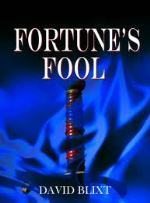 It was my realization that my hero was too much an Italian Francis Crawford that led to the huge reveal at the end of The Master of Verona, which was as much a surprise to me when I wrote it as it was to the many readers who’ve contacted me in a rage. Since then I’ve tried not to be so obviously influenced by her. Yet her storytelling is in my bones, the same way the stories of Colleen McCullough, Bernard Cornwell, and Rafael Sabatini are in me.
It was my realization that my hero was too much an Italian Francis Crawford that led to the huge reveal at the end of The Master of Verona, which was as much a surprise to me when I wrote it as it was to the many readers who’ve contacted me in a rage. Since then I’ve tried not to be so obviously influenced by her. Yet her storytelling is in my bones, the same way the stories of Colleen McCullough, Bernard Cornwell, and Rafael Sabatini are in me.
I’m drawn to grand stories, vast and world-exploring stories, tales of brilliant people in dark times. Dogged heroes struggling to maintain their integrity. Clever villains who think they’re the heroes. Intrepid soldiers and statesmen, clever and dangerous women, and a complex world where nothing is what it seems. These are the stories that I love to read, so these are the stories I try in my own humble way to write.
I hope they’re stories you’ll love to read.
~
The Master of Verona and its long-awaited sequels, Voice of the Falconer and Fortune's Fool , were published via Amazon Kindle in May at $2.99 apiece. (Yes, you should read them in order, and yes, there will be more to come in the Star Cross'd series.) Visit David Blixt's website for more on these and his other newly released novels, including Colossus: Stone and Steel , first in a new series set in Judea of 66 AD, and Her Majesty's Will , a zany Elizabethan romp which a reviewer called "Shakespeare's summer page-turner." Looks like fun plane reading for my trip to ALA.
As part of the interview, I asked David about Dorothy Dunnett and her influence on his work. In his reply, he stated: "Dunnett is, to me, the pinnacle of the genre. I have never felt an emotional punch the like of hers." In the following guest post, he expands upon that statement.
"My Queen"
by David Blixt
 The Star-Cross’d series (The Master of Verona, Voice of the Falconer, and Fortune's Fool) is set in early Renaissance Italy - the world of Dante and Giotto, of Popes and Emperors, of the highest hopes for chivalry and knights, combining Shakespeare’s Italian characters with the real people of Italy. This series owes a huge debt to my wife, Jan. Not only for all her support and eagle-eyed advice. She also was the one who introduced me to the works of Dorothy Dunnett.
The Star-Cross’d series (The Master of Verona, Voice of the Falconer, and Fortune's Fool) is set in early Renaissance Italy - the world of Dante and Giotto, of Popes and Emperors, of the highest hopes for chivalry and knights, combining Shakespeare’s Italian characters with the real people of Italy. This series owes a huge debt to my wife, Jan. Not only for all her support and eagle-eyed advice. She also was the one who introduced me to the works of Dorothy Dunnett. To me, Dunnett is the pinnacle of our genre. She touches every base, and does so with unforgettable characters, romantic settings, and history so vast and deep that one could easily drown, were her stories not so amazingly good. Jan loves to tell the story of me reading the third novel in the Lymond series, seeing what was about to happen to one of my favorite characters, and throwing the book down. For two years. I refused to let that character die. It was only my need to finish the series that brought me back again – and again. I truly adore Dunnett’s writing, her stories, her mind.
 While I’ve not attempted to emulate her (a pointlessly futile effort), Dunnett is in my head whenever I have a choice to make about the action. She plays a long game, and she’s brave in what she does to her characters, the same way that George R.R. Martin is brave – no one is safe. But there’s more hope in Dunnett than in Martin, and the threads are even tighter.
While I’ve not attempted to emulate her (a pointlessly futile effort), Dunnett is in my head whenever I have a choice to make about the action. She plays a long game, and she’s brave in what she does to her characters, the same way that George R.R. Martin is brave – no one is safe. But there’s more hope in Dunnett than in Martin, and the threads are even tighter. Dunnett also knew what I have to constantly remind myself – research is the key. She would let herself steep in research, allowing all the elements to merge and meet, then pour them into a single chapter. I’m continually astonished when the answer to a writing problem is answered by some obscure bit of historical trivia – death doors? Saddle tricks? Deadlines? A quirk of falconry? These things have not only saved me, they’ve become lynchpins for my stories.
 It was my realization that my hero was too much an Italian Francis Crawford that led to the huge reveal at the end of The Master of Verona, which was as much a surprise to me when I wrote it as it was to the many readers who’ve contacted me in a rage. Since then I’ve tried not to be so obviously influenced by her. Yet her storytelling is in my bones, the same way the stories of Colleen McCullough, Bernard Cornwell, and Rafael Sabatini are in me.
It was my realization that my hero was too much an Italian Francis Crawford that led to the huge reveal at the end of The Master of Verona, which was as much a surprise to me when I wrote it as it was to the many readers who’ve contacted me in a rage. Since then I’ve tried not to be so obviously influenced by her. Yet her storytelling is in my bones, the same way the stories of Colleen McCullough, Bernard Cornwell, and Rafael Sabatini are in me. I’m drawn to grand stories, vast and world-exploring stories, tales of brilliant people in dark times. Dogged heroes struggling to maintain their integrity. Clever villains who think they’re the heroes. Intrepid soldiers and statesmen, clever and dangerous women, and a complex world where nothing is what it seems. These are the stories that I love to read, so these are the stories I try in my own humble way to write.
I hope they’re stories you’ll love to read.
~
The Master of Verona and its long-awaited sequels, Voice of the Falconer and Fortune's Fool , were published via Amazon Kindle in May at $2.99 apiece. (Yes, you should read them in order, and yes, there will be more to come in the Star Cross'd series.) Visit David Blixt's website for more on these and his other newly released novels, including Colossus: Stone and Steel , first in a new series set in Judea of 66 AD, and Her Majesty's Will , a zany Elizabethan romp which a reviewer called "Shakespeare's summer page-turner." Looks like fun plane reading for my trip to ALA.
Published on June 19, 2012 06:00



